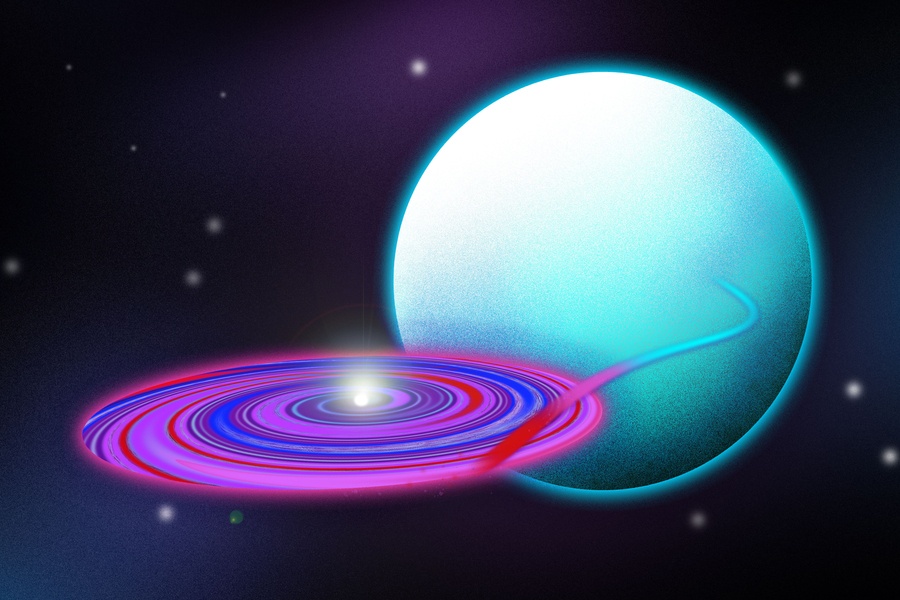There’s a wobbly X-ray-bright binary object in our galaxy called Hercules X-1 that’s blowing a mighty wind off to surrounding space. The system consists of a neutron star paired with a sun-like star. The neutron star is drawing material away from its companion. Its resulting accretion spins rapidly, and that whips up powerful winds. They affect the region of nearby space. That’s eerily similar to how a quasar’s central black hole sends out winds to influence its entire host galaxy.
A team led by Peter Kosec, a postdoctoral researcher at Massachusetts Institute of Technology (MIT), wanted to measure the winds blowing off of Hercules X-1’s accretion disk. That’s because its wobble gives them a unique perspective.
“The disk is really wobbling over time every 35 days, and the winds are originating somewhere in the disk and crossing our line of sight at different heights above the disk with time,” said Kosec. “That’s a very unique property of this system which allows us to better understand its vertical wind properties.”
By taking advantage of the wobble (called “precession) it experiences, Kosec’s team got measurements of the wind from different perspectives. The result is a two-dimensional map of the wind’s vertical shape and structure. The measurements also tracked varying wind velocities at different lines of sight, ranging from 250-800 km/sec. The team’s analysis suggests the wind variations are connected to the disk wobble. It appears that the wind “structure” precesses along with the disk.
“Taking X-rays” of the Neutron Star’s Disk and Winds
The team used two X-ray telescopes—ESA’s XMM-Newton and NASA’s Chandra Observatory—to look at Hercules X-1. That provided a view of the edge of the neutron star’s spinning disk moving up and down as it wobbled. “What we measure is an X-ray spectrum, which means the amount of X-ray photons that arrive at our detectors, versus their energy. We measure the absorption lines or the lack of X-ray light at very specific energies,” Kosec said. “From the ratio of how strong the different lines are, we can determine the temperature, velocity, and the amount of plasma within the disk wind.”
The observations showed signs of disk winds at changing heights, rather than at a single, fixed height above a uniformly rotating disk. The X-ray emissions and absorption lines revealed the temperature and density of the winds at various heights above the disk. That data was then used to construct a two-dimensional map of the wind’s vertical structure. “What we see is that the wind rises from the disk, at an angle of about 12 degrees with respect to the disk as it expands in space,” Kosec says. “It’s also getting colder and more clumpy, and weaker at greater heights above the disk.”
Neutron Star Winds and Quasar Winds

At first glance, the wind action around Hercules X-1 seems similar to what happens around supermassive black holes in the cores of galaxies. Quasars, for example, have these embedded black holes with winds blowing off their accretion disks. For most accretion disk systems, however, astronomers have very limited points of view. They don’t always get to see one wobbling, as Hercules X-1 does.
Kosac points out that if astronomers can map disk winds around a variety of objects, from neutron stars to quasar cores, it could give them a lot more insight into how these objects influence their surroundings. They could play a role in shaping other actions in the universe at large. To find out more, astronomers need to measure more wobbling systems. Mapping them could give insight into how disk winds influence the formation and evolution of stellar systems. In the case of quasars, it could help them understand the influence on entire galaxies.
Determining Origins of the Disk Wind
Disk winds are actually the result of the accretion disk around a massive object as it attracts material. Think of them as gigantic whirlpools of gas and dust often seen around neutron stars and black holes. As they spin, they whip up these powerful winds that actually push and pull on the plasma in the disk. At their most powerful, the disk winds from these objects heat up and blow away gas and dust.
It’s not completely clear how the winds get started in the first place. In an X-ray binary system, they could be the result of radiation from the neutron star heating up and evaporating the surface of the disk. The material could shred off the disk and create gusty winds. Or, the tremendously strong magnetic field of the neutron star could be shredding the disk and blasting material out to space. These latest MIT observations could provide a valuable tool for analyzing how all such winds form.
For More Information
Scientists map gusty winds in a far-off neutron star system
Vertical wind structure in an X-ray binary revealed by a precessing accretion disk
Vertical wind structure in an X-ray binary revealed by a precessing accretion disk (open source version)
Gemini Detects Most Energetic Wind from Distant Quasar — Background info on Winds at a Quasar

